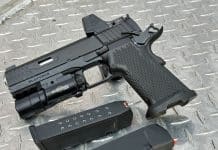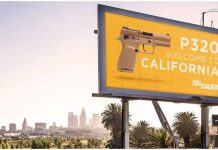
For as often as law enforcement officers conduct activity around vehicles, one would think that the training related to such occurs all of the time. The sad reality is tactics around, especially involving the use of firearms, is a limited training topic. While many officers conduct vehicle stops or contacts regularly, and even “high risk” stops at varying degrees of frequency, actual training on modern techniques based on the study of human nature and actual incidents is rare. This class covered handgun and patrol rifle.
When I was asked to attend 88 Tactical’s High Threat Vehicle Engagement course, I, of course, was interested, but also cautious. I have attended a few classes or training events with vehicles as the topic of focus, and some are based on realistic sound concepts, others are simply volume of fire exercises with the vehicle as a prop. This class was also closed to law enforcement only, after taking the course and learning the content was specifically geared towards law enforcement tactics it was applicable. On that topic, some vehicle courses I have attended the lessons were as applicable to an assault response or car-jacking, so open enrollment made sense. This course, the material was focused on traffic stops, higher risk as well as contacts, assaults on officers, and when things don’t go right. Generally, I am a proponent of open enrollment, but for this class, I think the average student, even the switched on ones that aren’t in active LE, wouldn’t have found the material as applicable as they aren’t pushing a squad and conducting enforcement activities.
Disclosure, while I did attend the course with a waived tuition fee, I did provide my own travel expenses, lodging, meals, ammunition, and of course, on my own time. I was not paid or compensated financially by 88 Tactical. Those that know me know that I truly view time as our greatest asset, so for me, the investment is still legitimate. This course was a two-day course a few hours away in southern Minnesota. Not to encourage you to stop reading, but I am glad I attended and found the class very worth my time and would have felt the same as a paying student.

Lead Instructor Dustin Mowery 
Instructor Aaron Guzman
The lead instructor was Dustin Mowery, a well-spoken, knowledgeable, personable, full-time police officer, and trainer out of Ohio. Dustin shared his background not just on work experience but also his background teaching and what prepared him to be our instructor. Assisting him was Aaron Guzman, a deputy sheriff in Minnesota, an experience SWAT member, and one heck of a great guy. I’ve had the pleasure of connecting with Aaron before and always look forward to our paths crossing. Aaron assisted in demonstrations and also offered some excellent insight with his jiujutsu experience when the topic of physical extraction came up later in the course.
One of the most important critical questions a student must ask and review when attending training is, Why? This isn’t meant to be done in an insulting or critical matter, but one needs to learn the why of a concept to understand better how it applies. Good instructors, in any topic, will explain the why naturally where it is explained to reinforce the lesson and provide that it is sound, practical, and applicable. If an instructor struggles with the why portion, while they may have the best of intentions, they may also struggle to understand the topic themselves truly. In this case of Dustin and Aaron, they explained the why in detail and with a realistic explanation and delivery. This course was developed and instructed to provide law enforcement with better, modern tactics when engaging in, around, and near vehicles.

The class began with classroom sessions each day. The presentation was relevant to the course and not just tactical storytelling. I am not going to publish the material outline in replicating detail. The reality is with a topic like this; there is truly no substitute for practical, quality training. The lecture explained the background of why the material was developed and reinforcement the material much more than it could be talking in front of the berm. Videos from officer-involved shootings were shown not just highlighting what happened, but also examining indicators prior to the incident that were common themes. Knowing what to look for one could start to watch other videos and see indicators. Dustin also shared some feedback he has received from student officers and how they were applying the lesson learned and some success stories.
My litmus test for training is it realistic, current, and relevant to what an officer will need on the street serving their community. I found this class met all three. Sometimes classes attended are for the rare scenarios, which is sadly a requirement in modern law enforcement practice. What I truly appreciated about this course was that there were many concepts that I immediately brought back home and started using on patrol and will be sharing with my co-workers on better ways to do what we do. Make no mistake; I am a street cop for a small town; however, we do make traffic stops daily, and high risk stops when needed. The techniques explained, demonstrated, and practiced in class are an improvement in those areas.

The range session began with some fundamental review and exercises. While this wasn’t geared as a fundamental course, this step is critical for the instructors to perform an assessment of what they are dealing with, not just with marksmanship but also general gun handling and manipulation skills. Being the class would advance towards rapid movement around vehicles, with a partner and engaging a wide array of targets, making sure everyone was up to speed was a must.
The class had 19 shooters ranging from small municipal officers, deputies, and just under half being US Deputy Marshalls who all work in fugitive apprehension. Networking with the federal agents was also a benefit, hearing and learning how their experiences around vehicles occur and the tactics applied are relevant to their duties. Most of the officers were equipped with patrol type handguns with two of us running red dot equipped handguns. Patrol rifles with red dots and a couple of LPVO’s made the course. Staying true to my luck, every class I teach or attend, at least one gun goes down, and this was no exception. One patrol rifle, an entry-level brand, started to have issues and was swapped for a spare. One other rifle had a castle nut loosen as well. Training is a great way to test your gear, and training isn’t just to learn new techniques and tactics but also see if the equipment works as it should.


The first range session wrapped up with ready positions, carry positions, presentation of the gun, and moving with a gun. Emphasis was stressed that this was critical as when the drills evolved to movement and shifting targets, each officer is still accountable for professional gun handling and ultimately responsible for every round fired. When drills were repeated with the rifle, the manipulation of safety was also required, which is always a welcome practice. Sadly there are still some out there with the “my finger is my safety” mentality, but that’s another article.
Students test-fire various firearms, calibers, and bullet types in various areas of the vehicle and then examine performance.
We then shifted to a vehicle ballistic demonstration. While I have had the pleasure of shooting several vehicles in the name of training, many this was their first time to see and examine what happens to the vehicle and bullet. We fired a variety of handgun rounds, rifle rounds, shotgun rounds, and one student was even nice enough to bring out a .500 Magnum, which would make the Tackleberry proud in all of us. Glass, body panels, A, B and C pillars, dashboards, seat material and even vehicle contents all affected ballistic performance. We placed targets in and around the vehicle, and students took turns shooting various tests for the class to observe and then analyze and dissect. We studied windshield, door panels, pillars, and glass tracking each round of where it went, if it was stopped and where it went. Several of the rounds were also recovered where we could see how the round was affected, looking at jacket performance and weight retention. I am by no means a science guy, but vehicle ballistic performance is something that always interests me.
The author firing his patrol round, Speer 75 gr Gold Dot, noting entry and exit of rounds through both B pillars of vehicle.
The class then covered vehicle stops and how officers should, and shouldn’t approach a vehicle. While this may seem like a well-covered subject, approaching the topic with a focus on tactics was made with a new presentation on setting up an advantage for the approaching officer. Using the various test vehicles, the students rotated in and out of multiple roles getting the first-hand perspective on the new techniques. These techniques increased officer visibility, reduced the driver’s, and set up better positions for cover if the driver did a variety of actions. Some were skeptical, but when testing the techniques over and over, the proof was evident as the officer could reset to a position of advantage most times well before the driver was even fully out of the car. The techniques were very effective but even better, also very simple and repeatable. Sadly some tactics taught require such setup and are so complex that applying them in actual use can be difficult. These techniques I brought back and started using my first shift back on patrol.
The author taking his turn in traffic stop scenarios, these drills demonstrated and reinforced officer positions for visibility, cover, and movement advantages.
The shooting drills of the class were the majority of the content. In total, we fired approximately 600 rounds of handgun both days and approximately 430 rounds of rifle on the second day. The drills focused around vehicles, and both Dustin and Aaron watched closely to make sure the vehicle was correctly used. The drills offered simulated stress, and challenges, requiring some students needing to be coached on position and movement near the vehicle. The goal of the drills was to practice and reinforce the lessons. As a beneficial side effect, sometimes odd things would happen, such as a round striking the narrowest part of a windshield wiper. If one were to bet on the impact, one could guess minimal, but at times these little obstacles made a significant change to the course of the round.

The drills progressed with more targets, more movement, more complex set up requiring not just movement but processing of information, and then a plan and execution to locate and respond to a threat. From the outside, with no context, one may see a plethora of targets and would assume we are planning for some sort of invasion. The reality is threats move and the amount of targets simulate the target moving and not just standing in one place, static and square to the shooter. We know this doesn’t happen in real life, but yet so many training programs still keep targets static and square, again another topic. Targets were places in, out, and around the vehicle at various locations to keep the challenge high. When watching other students run the scenarios, it was easy to connect the student movement and simulated target movement to some of the videos we reviewed in class.
To add to the drills, students worked in pairs and with the patrol rifles. Students had to respond, communicate, and plan while responding to the called threats. Adding complexity as scenarios continued, students faced troubleshooting gear by either induced stoppages or by finding a rifle sling tangled or gear problems to solve. At first, I was a little dismissing of messing with my rifle as it’s not how I would store my rifle, for example. But looking at it from a true training perspective, it is a stress factor requiring the student to solve the problem adding complexity to the scenario. And it worked. The added tasks required one to go beyond a generic rehearsed range response and figure out what the problem is and fix it while communicating with your partner, moving, seeking the target, and responding to the threat.
In the last segment of the class, we looked at alternate methods to conduct high-risk stops and driver extraction. These concepts were extremely well done and offered realistic tactics that are significantly improved on dated traditional methods. If one has worked on the street for any amount of time, you see many times how high-risk stops turn into a hot mess. The way we have done high risk stops as an industry could use updating, especially when we review what happens when shots are fired. The concepts presented use those real-life situations and human nature to adjust tactics that make sense.
Another common situation with LE is extracting a subject from a vehicle that does not cooperate with the arrest. The vehicle is a unique, confined area that is very limiting for proper physical engagement. The door, pillars, seats, steering wheel, and seat belt all add barriers when trying to effect an arrest. Aaron demonstrated a few techniques for driver extraction that not just actually worked but were simple enough to retain and replicate in the future. Jujitsu is finding its way into more and more modern use of force training and rightfully so. These techniques build off of basic jujitsu methods and transfer them from the ground to the vehicle. Students had the opportunity to rotate as the subject and officer role to not just test and perform the techniques but also validate them as we didn’t just give in the student officer. This alone could be a specialized class and one that I would eagerly attend.
This article quite frankly doesn’t and can’t truly capture the concepts presented and learning that occurred. There is no substitute for actively participating in quality training, especially a topic as focused as vehicle engagements. Having actual vehicles, knowledgeable instructors with solid material just can’t be replaced by reading or watching online. One needs to get quality training that engages cognitive processing, physical application, and reinforcing practice to build knowledge and ability.
This overall was an excellent class, and I found it well worth my time. My only criticism of the class was there was some downtime for students during some of the shooting scenarios. The only way to avoid this would be to add additional instructors, vehicles, and range area to allow for additional scenarios to occur. Even as I list that, as more of heads up to potential students, the reality is watching your fellow students go through the scenarios can be a beneficial process in learning how one responds to scenarios. Many of us in the group were instructors ourselves, and seeing how some reacted to stress or obstacles gave us insight on highlighting certain aspects or teaching points.
While we all want to shoot more when we attend classes, observing other students loops back to concepts presented early and throughout the class. This course was developed and conducted with a focus on human behavior under stress. Things that we saw in the classroom officer-involved shooting videos, getting too close to cover, exposing from cover, or not using cover were all things we saw happen on the range. When these occurred students were coached and built up to using better techniques. Aaron had a great saying to summarize this, “Better position allows for a better decision, that equals better precision.” The concepts in the class build on what humans typically do naturally under stress and realign and tune them for effective and simple solutions.
If you work in law enforcement and are looking for practical, relevant training with a modern approach to vehicle engagements, I am confident you will find this class beneficial.
Stay safe out there!
-DT

Learn more at 88Tactical.com.
Be sure to check out more from our Reviews section.
Want more posts like this one? Subscribe to Guns & Tactics Magazine to receive email updates and special offers direct to your inbox!
* The views and opinions expressed on this web site are solely those of the original authors and contributors. These views and opinions do not necessarily represent those of Guns & Tactics Magazine, the administrative staff, and/or any/all contributors to this site.






















